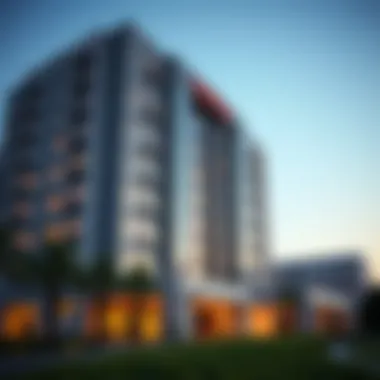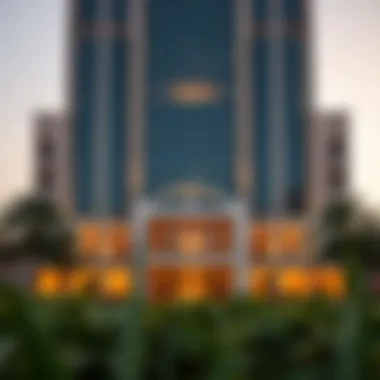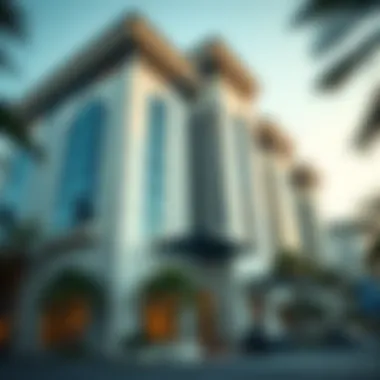Abdulla Building: Architectural Importance and Real Estate Trends


Intro
The Abdulla Building stands as a remarkable example of modern architecture in Dubai, merging historical significance with cutting-edge design. Situated in a bustling cityscape, it has evolved from a mere structure to a pivotal component of the real estate framework that influences investor behavior, urban development, and cultural landscape in the region. This overview offers a detailed examination of various elements contributing to the building's formidable reputation—culminating in a deeper understanding of its value in the dynamic atmosphere of Dubai's property market.
One cannot underestimate the impact of architecture on the identity of a city, especially in a metropolis like Dubai, which is famous for its skyline and innovative structures. The Abdulla Building, with its unique blends of styles and functions, reinforces this notion by presenting an alluring façade that captures the awe of both residents and tourists alike. Beyond aesthetics, its designed spaces interface gloriously between commercial viability and cultural relevance.
Additionally, as the demand for real estate in Dubai continues to surge, the need for thorough market insights becomes paramount. Thus, understanding the dynamics at play in the real estate sector surrounding this iconic building not only enhances appreciation but also aids potential investors.
In the sections that follow, we will explore market insights, investment strategies, and the architectural features of Abdulla Building, aiming to equip interested parties with enriching knowledge and strategic foresight that translates into sound investment decisions.
Prolusion to Abdulla Building
The Abdulla Building stands as a testament to the architectural prowess and ambitious urban development that has defined Dubai in recent decades. Its significance stretches beyond mere structure; it represents a fusion of tradition and modernity, encapsulating the spirit of a city that has rapidly evolved into a global powerhouse. As one dives into its intricacies, understanding the historical setting and architectural uniqueness becomes pivotal. By examining these elements, one gains a clearer perspective on how this landmark contributes to the ever-changing skyline of Dubai.
Historical Context
To grasp the true essence of the Abdulla Building, one must first consider the historical backdrop against which it was erected. The city of Dubai has undergone a vast transformation from its modest beginnings centered around pearl diving and fishing.
In the late 20th century, Dubai began embracing modernization at an unprecedented pace, especially during the 1990s and early 2000s. The introduction of strategic vision pillars by Sheikh Mohammed bin Rashid Al Maktoum laid the foundation for Dubai to position itself as a business and tourism hub. It is within this renaissance that the Abdulla Building emerged, marked not just as a physical structure, but as a symbol of the ambitions of a rapidly developing emirate.
The architectural narrative of the Abdulla Building intertwines with local history, cultural identity, and international influences. Its design echoes elements found in classical Arabian architecture, while simultaneously acknowledging contemporary styles that have become prevalent in modern buildings throughout the region. This blend allows for a rich tapestry of design that tells an ongoing story of progress and adaptation, reflecting both a respect for tradition and a forward-looking perspective.
Architectural Style
The architectural style of Abdulla Building serves as a visual representation of Dubai’s journey into modernity, utilizing cutting-edge construction techniques and materials. The facade is accentuated with glass and steel, showcasing a harmonious blend of transparency and strength. This choice not only facilitates natural light but also symbolizes the openness of Dubai to global investments and ideas.
Key features of the architectural design include:
- Fluid Lines: The building's contours are soft and flowing, reminiscent of the undulating sands of the UAE’s deserts.
- Sustainable Design Elements: Incorporation of green spaces and energy-efficient technologies are evident, aligning with global sustainability goals and Dubai's vision for environmentally conscious development.
- Cultural Motifs: Intricate patterns inspired by traditional Emirati art adorn specific parts of the structure, establishing a dialogue between the old and the new.
Design Features of Abdulla Building
The design features of Abdulla Building stand as a testament to the innovative architectural methods and considerations pivotal in contemporary real estate. These elements not only enhance aesthetic appeal but also represent the strategic integration of functionality and sustainability, vital in today's urban landscape. As investors and real estate enthusiasts delve into the intricacies of this structure, understanding its design becomes essential. Each aspect reveals insights into how architecture can influence both the market value and community interaction within Dubai.
Materials Used
A notable characteristic of the Abdulla Building is its selection of materials, which blend traditional and modern approaches. The façade exhibits a mixture of concrete, glass, and steel, which adds a contemporary flair while ensuring durability. This unique combination doesn't just look good; it also caters to the regional climate by reflecting sunlight, thereby reducing heat absorption.
Additionally, the use of locally-sourced materials illustrates a commitment to supporting the community while minimizing environmental impact. The intention behind these choices is not simply to meet aesthetic standards but to align with functional requirements, easing the building's maintenance and operational efficiency over time.
"The right materials can transform a structure from ordinary to extraordinary, ensuring it stands the test of time and elements."
Interior Layout
The interior layout of Abdulla Building is crafted with an emphasis on flow and usability. Upon entering, one is greeted with spacious lobbies and thoughtfully planned common areas designed to encourage interaction. Open-plan offices reflect modern workplace trends, catering to collaborative environments that foster creativity and productivity.


Private offices and meeting rooms feature soundproofing materials, ensuring a quiet working atmosphere. This balance between open space and privacy allows tenants to operate effectively, attracting diverse business sectors.
Moreover, strategic placement of windows maximizes natural light, contributing to a more appealing, healthier workspace that can heighten productivity. This focus on employee wellbeing can significantly impact tenant satisfaction and retention—an aspect highly valued in the competitive Dubai real estate market.
Sustainability Aspects
As the global conversation shifts towards sustainability, Abdulla Building doesn't lag behind; its design incorporates several eco-friendly elements. For example, a rainwater harvesting system is in place, leading to reduced water consumption. This initiative not only supports the environment but also lowers operational costs, making it an attractive prospect for investors.
Furthermore, energy-efficient systems like LED lighting and smart thermostats have been installed to promote responsible energy use. These features inherently appeal to forward-thinking corporations and tenants who prioritize sustainability in their operational decisions.
Through such innovations, Abdulla Building sets a benchmark for future developments in Dubai, highlighting the trend towards green architecture within the real estate sector. Investors looking for properties with long-term viability should heavily consider these aspects, as sustainability increasingly influences market trends.
Current Market Trends in Dubai Real Estate
Understanding the current market trends in Dubai's real estate sector is crucial for any investor or stakeholder interested in the Abdulla Building. The landscape is constantly shifting, influenced by various factors that affect demand, pricing, and investment strategies. The importance of gauging these trends extends beyond mere numbers; it offers insights into the evolving needs of businesses, residents, and tourists alike.
Demand for Commercial Spaces
In recent years, there has been a significant uptick in demand for commercial spaces in Dubai. Numerous factors contribute to this phenomenon:
- Rapid Economic Growth: With the UAE's economy bouncing back post-pandemic, businesses are clamoring for office space to capitalize on new opportunities.
- Diverse Business Environment: Dubai has become a hub for international companies, especially in sectors like tech, finance, and tourism. This influx is steadily increasing the need for modern, well-located commercial spaces.
- Lifestyle Changes: The flexible working models emerging after the COVID-19 pandemic are reshaping how companies utilize office spaces. Businesses are focusing more on open layouts, collaborative areas, and amenities that cater to a contemporary workforce.
Investors keen on properties like the Abdulla Building will find it increasingly appealing due to its location and design features that align with the demands of modern businesses.
Influence of Global Events
Global events wield a powerful influence on local markets, and Dubai is no exception. These events can shift market dynamics in several ways:
- Expo 2020 Impact: Although delayed, the Expo was a significant draw and showcased Dubai’s infrastructure to millions worldwide. This globally recognized event was expected to spur interest in investments, especially in commercial real estate.
- Geopolitical Factors: Regional stability is a hot topic, and any geopolitical affair can have ripple effects on investor confidence and market stability.
- Economic Policies: Changes in global economic policies, interest rates, and trade relationships also play a role. Investors often adjust their strategies based on these external economic signals.
Therefore, it’s prudent for those considering investing in commercial spaces like the Abdulla Building to keep an eye on international happenings. Being attuned to these influences allows for more informed decisions in an unpredictable real estate market.
"In a volatile environment, knowledge is power. Keeping a pulse on market trends and global events can safeguard your investments."
In summary, comprehending the demand for commercial spaces and the broader implications of global events is invaluable for stakeholders in the Dubai real estate market. As one navigates through various trends, the Abdulla Building stands out as a potentially lucrative investment opportunity, reflecting the changing tides within the city's commercial landscape.
Investment Potential of Abdulla Building
The investment potential of Abdulla Building is a crucial aspect of its significance in Dubai's evolving real estate market. As property enthusiasts and investors look for opportunities that promise value retention and growth, this landmark structure offers insights worthy of exploration. The building's strategic location, architectural appeal, and the broader trends within the Dubai market create a unique investment landscape that cannot be overlooked.
Comparative Property Value Analysis
When comparing the property values in the vicinity of Abdulla Building, several factors emerge that underscore its investment appeal. Firstly, the surrounding area has seen a steady appreciation in property prices over the last few years. Since the structure is nestled in an established neighborhood, it benefits from the increasing demand for both residential and commercial spaces.
- Market Comparisons: The property values in the immediate vicinity typically range higher than the city average, suggesting a strong demand among potential buyers and renters.
- Rental Yields: Investors can expect favorable rental yields, often exceeding 6-7%, which is considerably attractive in the current climate of fluctuating markets.


Moreover, the architectural significance of the Abdulla Building combined with its modern amenities further enhances its market position. Properties that boast unique designs often fetch higher prices not only because they stand out visually but also because they attract a niche market willing to pay a premium.
"Investing in a property like Abdulla Building is not just about purchasing a space; it’s about securing a piece of a growing legacy in Dubai's architectural and economic landscape."
Future Development Plans
Future development plans surrounding Abdulla Building indicate a strong potential for even greater returns. The Dubai government has invested substantially in infrastructure improvements and urban enhancements that are set to unfold in the coming years.
- Transportation Initiatives: Upcoming transportation links, including new metro stations and improved road networks, will significantly increase accessibility and desirability for the area. Such enhancements tend to rally interest from both local and foreign investors.
- Cultural and Recreational Projects: There are also plans for parks, community centers, and cultural hotspots in the vicinity. As these developments materialize, they promise to boost foot traffic, improve the living experience, and thus increase property values.
For real estate investors, it is essential to monitor these development initiatives closely. An area that is set to grow not only in physical infrastructure but also in cultural vibrancy often translates to long-term appreciation in property value.
In summation, the investment potential of Abdulla Building is underscored by careful analysis of property values and infrastructural developments. Both factors present compelling reasons for investors to consider this landmark as a valuable asset in their portfolios. The strategic vision unfolding in Dubai renders Abdulla Building a promising choice for prudent investors.
Community Impact of Abdulla Building
The Abdulla Building doesn't just stand tall as an architectural feat but also plays a vital role in the community around it. The significance of this structure extends beyond its physical presence into the everyday lives of the people in its vicinity. It acts as a catalyst for local development, offering various social and economic benefits that ripple through the neighborhood and beyond.
Role in Neighborhood Development
The location of the Abdulla Building has a profound impact on neighborhood development. It serves as an anchor point for various businesses, prompting growth in surrounding areas. As new shops, cafes, and offices flourish nearby, they enhance the overall quality of life for residents. Here are some specific aspects of its role:
- Economic Growth: The building attracts investment, leading to job creation and stimulating local commerce. When a prominent building rises in an area, it often serves as a beacon, enticing businesses to set up shop nearby, thus creating a vibrant economic landscape.
- Infrastructure Improvement: With increased activity comes the need for enhanced infrastructure. Roads, public transport options, and utilities often see upgrades, making the surrounding area more accessible and appealing for residents and visitors alike.
- Community Services: The Abdulla Building can serve as a hub for community services, offering spaces for meetings, events, and gatherings. This encourages community spirit and adds a touch of unity among residents, fostering local connections.
Cultural Contributions
Cultural contributions are another significant facet of the Abdulla Building's influence in the community. The architectural style often reflects local traditions while embracing modernity. This unique blend doesn't only benefit residents; it attracts tourists and fosters an appreciation for local culture. Here are a few points to consider:
- Artistic Representation: The building itself can act as a canvas for local artists. Murals or installations that celebrate the community’s heritage can be integrated into its design, turning the structure into a symbol of local identity.
- Cultural Events: Hosting cultural events can be another avenue for the Abdulla Building to impact the community. From exhibitions showcasing local talent to festivals celebrating the area's rich heritage, the building offers a venue that brings people together, enriching their experience.
- Educational Opportunities: The space can provide avenues for educational initiatives, such as workshops or lectures on architecture, art, and culture. This not only educates residents but also instills a sense of pride in their locale.
"A building is not just bricks and mortar; it’s the life that it nurtures within and around it."
In summary, the community impact of the Abdulla Building is multilayered. It fosters neighborhood development through economic growth and infrastructure improvements, while also contributing to cultural richness through artistic representations and community events. As the building continues to thrive, so too does its community, creating an environment that harmonizes growth and tradition, ultimately setting a benchmark within the city.
Challenges and Considerations
In the realm of real estate development, especially concerning a notable edifice like Abdulla Building, one must wrestle with various challenges and considerations that are both immediate and long-term. Recognizing these hurdles is crucial, as they significantly affect potential investments, operational sustainability, and overall market dynamics in Dubai. Here, we delve into two primary challenges: regulatory hurdles and market volatility.
Regulatory Hurdles
Navigating the complex landscape of real estate regulation in Dubai requires a keen understanding of local laws and ordinances. Regulatory frameworks can often be a labyrinth, with myriad rules governing everything from land use to building codes. For Abdulla Building, this means adhering to specific guidelines that shape how the structure can be utilized and modified.
- Permitting Process: Acquiring the necessary permits can be cumbersome. Developers and investors must wade through an often lengthy approval process from municipal authorities, which can delay projects or incur additional costs. It’s crucial for stakeholders to stay informed about changing regulations that might impact their endeavors.
- Zoning Restrictions: Understanding zoning laws is vital. These regulations dictate what kind of activities can occur within a building, which can heavily influence its profitability. If the zoning does not align with market demand—say, if the area is zoned primarily for commercial use but the demand leans towards residential—this mismatch can stall growth.
- Compliance Costs: Ensuring a building meets all safety and environmental regulations can mean hefty costs. Investors must factor these potential outlays into their financial plans. Failure to comply could lead to fines or, worse, halting operations altogether.
Adhering to these regulatory requirements, though challenging, paves the way to a successful and sustainable investment in Abdulla Building.


Market Volatility
Market volatility poses another significant consideration for investors eyeing Abdulla Building. Dubai’s real estate market, known for its rapid fluctuations, can either present golden opportunities or daunting challenges. Insight into market trends can lend an advantage.
- Economic Influences: Local and global economic changes can dramatically affect property values. For instance, factors like employment rates, oil prices, and international trade agreements can lead to fluctuations in demand for real estate. Investors need to be acutely aware of these economic indicators.
- Investor Sentiment: Psychology often drives market movements. Sentiment can shift swiftly due to world events or economic forecasts, impacting property values. Keeping a pulse on the collective mindset of investors can help predict trends and avoid possible pitfalls.
- Supply and Demand Dynamics: An oversupply of commercial or residential properties can lead to decreased values. Conversely, if demand spikes with limited supply, property values are likely to soar. Investors must conduct thorough market analyses to gauge the health of their investment now and in the future.
Staying aware of market conditions and regulatory constraints can provide a strategic edge to prospective investors in the Abdulla Building.
In summary, the challenges and considerations outlined here emphasize the importance of due diligence for anyone involved with Abdulla Building. Understanding the regulatory landscape and anticipating market trends are essential for maximizing success in this vibrant real estate environment.
Future of Abdulla Building and Surrounding Area
The future of Abdulla Building holds significant importance not only for its architectural stature but also for the broader implications it has on the surrounding area. As a focal point in Dubai's evolving skyline, its relevance extends beyond just a structure; it embodies community development, urban evolution, and economic potential. With rapid urbanization and increasing congestion in major cities, understanding the trajectory of such buildings is vital for investors and stakeholders alike.
Urban Planning Perspectives
When analyzing the future of the Abdulla Building, urban planning perspectives play a crucial role. This structure finds itself positioned amidst a tapestry of diverse urban activities. The city of Dubai continually focuses on sustainable development, promoting smart city initiatives that align with ecological responsibility and efficiency.
- Zoning Regulations: As Dubai navigates growth, maintaining effective zoning regulations becomes essential. The Abdulla Building may influence future zoning practices, potentially rating developers' proposals depending on how well they complement the existing architectural style and community ethos.
- Social Infrastructure: Building on the urban planning framework necessitates enhancing the surrounding areas. Improvements in local amenities such as parks, transportation networks, and retail spaces could increase the area’s attractiveness. Prospective changes could encourage more foot traffic, benefiting businesses nearby, creating a win for community builders and property investors.
- Public Transport Integration: Another focus for urban planners is ensuring connectivity. Integration with public transit systems can boost the accessibility of Abdulla Building. By establishing key transport hubs or enhancing existing lines, planners can significantly enhance the building's user experience and increase its appeal for commercial ventures.
Predicted Market Evolution
Looking ahead, the predicted market evolution surrounding Abdulla Building paints a complex yet promising picture. Several factors will shape this evolution:
- Economic Fluctuations: The economic landscape is ever-shifting; understanding its impact on real estate is paramount. If Dubai continues fostering modern investment avenues and attractive tax regimes, property values around Abdulla Building could see a positive trajectory, attracting investors eager for growth.
- Technological Advancements: The property market is increasingly underpinned by technological influence. Trends like IoT-enabled buildings and smart homes can redefine attraction, especially for tech-savvy renters and buyers. Investors who embrace this technological evolution could tap into new revenue streams.
- Cultural Shifts and Preferences: Understanding demographic shifts is crucial as well. Preferences for co-working spaces, flexible office solutions, and lifestyle-driven environments are rising. Abdulla Building needs to adapt to meet these demands, or it risks falling behind in the competitive market.
Abdulla Building isn’t just a building; it's a pivotal element in the evolution of its surroundings. Recognizing the intertwined nature of urban planning and market forces will be key for stakeholders interested in navigating the future effectively.
"In the world of real estate, standing still is moving backward. Understanding future trends helps us move forward."
As the landscape of Dubai continues to evolve, the future of Abdulla Building stands as a lens through which investors and developers can gain vital insights into broader market trajectories.
Closure and Final Thoughts
The Abdulla Building stands not merely as a structure of bricks and mortar but as a testament to the evolution of Dubai's architectural landscape and its real estate dynamics. This landmark encapsulates the story of a city that has transformed from humble beginnings into a global hub for commerce and culture. Understanding the implications of the architectural features and market trends surrounding this building helps clarify its significance in today’s fast-paced environment.
Summary of Insights
Throughout this article, we explored various dimensions of the Abdulla Building, from its historical context and architectural style to its pivotal role in Dubai's real estate scene. A few key takeaways include:
- The architectural importance of the building reflects a blend of traditional and modern design, showcasing Dubai's growth trajectory.
- The investor appeal of this property rests on its strategic location and the increasing demand for commercial spaces in Dubai.
- Community engagement and cultural contributions position the building as a cornerstone in the local neighborhood's development.
- Amidst market volatility, challenges such as regulatory hurdles need addressing for sustained growth in property values.
These insights collectively enhance our understanding of how the Abdulla Building influences both its environment and the broader marketplace, providing potential opportunities for various stakeholders.
Encouragement for Further Exploration
The interesting aspects of the Abdulla Building extend beyond its physical presence. For investors, realtors, potential homebuyers, and renters, exploring the nuances of this property can reveal numerous opportunities. Here’s why delving deeper into this subject is valuable:
- Real Estate Trends: Observing how the nearby developments impact property values will provide a clearer picture moving forward.
- Cultural Heritage: Engaging with the historical narratives associated with the building can foster a deeper appreciation for its significance.
- Networking Opportunities: Connections made through local events or gatherings can lead to fruitful collaborations in future projects.
"The true essence of a building lies not in its structure, but in the stories it tells and the lives it touches."



